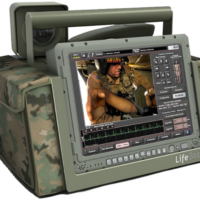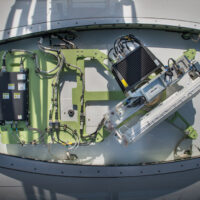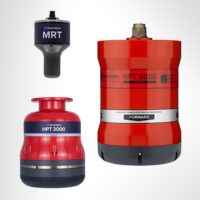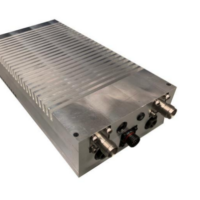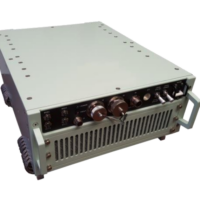Radio remains the dominant means of military communications since first used en masse during The Great War. Used by sea, land, air and space forces, radio is the most practical form of wireless communications across Line-of-Sight (LOS) and Beyond Line-of-Sight (BLOS) ranges.
Military Radio Communication Systems
A form of electromagnetic radiation, radio inhabits a specific part of the electromagnetic spectrum from frequencies of one hertz up to three terahertz. Beyond three terahertz, electromagnetic radiation becomes infrared light. A plethora of different radio frequencies are used for military communications as no single frequency performs all tasks demanded of radio equally well.
Range & Data Rates
Two of the most important considerations for militaries are range and data rates. The lower the frequency, the further a radio signal will go, but this comes at the expense of data rates. Data traffic basically encompasses everything that is not voice comms. This could include written information, positional data derived from a Global Navigation Satellite Signal and/or still and video imagery. The higher the frequency, the more traffic a signal carries but the shorter the range. Range deficiencies can be compensated for by increasing transmission power, but this may be constrained by the radio’s power source. This is a consideration for militaries where radios must accommodate space-constrained ships, vehicles, aircraft and personnel. Radios may also need to share power sources with sensors and weapons, restricting how much electricity they use.
Low Frequencies – VLF & ELF Communications
The lowest radio frequencies in routine military use encompass the ELF (Extremely Low Frequency) part of the radio spectrum between three and 30 hertz. ELF penetrates seawater and is used by a handful of nations for global shore-to-submarine communications. It achieves global ranges although tends to be used to carry data as it transmits only a few written characters per minute. Very Low Frequency (VLF) which uses frequencies of three kilohertz/KHz to 30KHz is in more widespread use for submarine communications. Like ELF, it has a global reach and penetrates seawater reaching minimum depths of 40 meters (131 feet). VLF has slightly better data rates reaching up to 300 bits-per-second, the equivalent of 450 words-per-minute.
High Frequencies – HF Communications
High Frequency (HF) communications are employed in defense by navies, armies and air forces. HF achieves intercontinental ranges as it uses the ionosphere. This part of the atmosphere is between 48,000 meters/m (157,480 feet) and 965,000m (3.1 million feet) above Earth. High frequency signals cannot penetrate the ionosphere and are bounced back to the surface. This gives them a BLOS (beyond line of sight) range as they can avoid the horizon which would otherwise block the link between two radios not in a LOS (line of sight) range of each other. While better than VLF, HF has comparatively slow data rates at best achieving rates of circa 120 kilobits-per-second.
Line of Sight Communications – U/VHF Radio
Unlike HF, Very High Frequency (VHF) and Ultra High Frequency (UHF) radio is mostly used for LOS communications and are popular for surface-to-surface defense communications for land and naval forces. V/UHF is also used for air-to-ground/ground-to-air communications. Using frequencies of 30 megahertz/MHz to three gigahertz, V/UHF is a step change in data rates. Such radios typically achieve speeds above one megabit-per-second.
There are some subtle differences between Very High Frequency (VHF: 30MHz to 300MHz) and Ultra High Frequency (UHF: 300MHz to three gigahertz) radio. Whereas VHF cannot penetrate solid obstacles like walls, this is less of a problem for UHF. Many military radios, particularly land forces’ tactical radios are ‘dual band’ V/UHF systems for this reason, the latter providing better performance in urban areas. Military Satellite Communications (SATCOM) also resides in the V/UHF band and above. SATCOM is discussed in more detail in our Military Satellite Communications entry.
Terahertz Radio
Over the longer term, military communications may migrate into the terahertz part of the radio spectrum. Challenges arise from the ongoing proliferation of cellular comms, exemplified by the advent of so-called fifth-generation or ‘5G’ cellular protocols. This puts more pressure on military users. Governments keep some of their national V/UHF spectrum reserved for military use. Radio spectrum auctions earn billions of dollars for governments which sell parts of the spectrum to cellular operators. Militaries may find their V/UHF use squeezed.
Although terahertz radio communications are in their infancy, intensive research efforts are ongoing in academe and industry on evolving this medium for military and civilian use.











